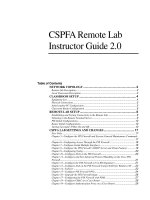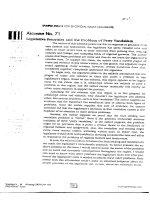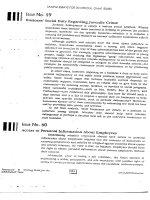Algebra GMAT guide 2
Bạn đang xem bản rút gọn của tài liệu. Xem và tải ngay bản đầy đủ của tài liệu tại đây (3.93 MB, 197 trang )
MANHATTAN PREP
Algebra
GMAT Strategy Guide
This essential guide covers algebra in all its various forms (and disguises) on the GMAT.
Master fundamental techniques and nuanced strategies to help you solve for unknown
variables of every type.
guide 2
Algebra GMAT Strategy Guide, Sixth Edition
10-digit International Standard Book Number: 1-941234-00-3
13-digit International Standard Book Number: 978-1-941234-00-6
eISBN: 978-1-941234-21-1
Copyright © 2014 MG Prep, Inc.
ALL RIGHTS RESERVED. No part of this work may be reproduced or used in any form or by any means—graphic, electronic, or
mechanical, including photocopying, recording, taping, or web distribution—without the prior written permission of the publisher, MG
Prep, Inc.
Note: GMAT, Graduate Management Admission Test, Graduate Management Admission Council, and GMAC are all registered
trademarks of the Graduate Management Admission Council, which neither sponsors nor is affiliated in any way with this product.
Layout Design: Dan McNaney and Cathy Huang
Cover Design: Dan McNaney and Frank Callaghan
Cover Photography: Alli Ugosoli
INSTRUCTIONAL GUIDE SERIES
GMAT Roadmap
Number Properties
(ISBN: 978-1-941234-09-9)
(ISBN: 978-1-941234-05-1)
Fractions, Decimals, &
Percents
(ISBN: 978-1-941234-01-3)
Critical Reasoning
(ISBN: 978-1-941234-02-0)
Algebra
Reading Comprehension
(ISBN: 978-1-941234-00-6)
(ISBN: 978-1-941234-06-8)
Word Problems
Sentence Correction
(ISBN: 978-1-941234-08-2)
(ISBN: 978-1-941234-07-5)
Geometry
(ISBN: 978-1-941234-03-7)
Integrated Reasoning &
Essay
(ISBN: 978-1-941234-04-4)
SUPPLEMENTAL GUIDE SERIES
Math GMAT Supplement Guides
Verbal GMAT Supplement
Guides
Foundations of GMAT Math
Foundations of GMAT Verbal
(ISBN: 978-1-935707-59-2)
(ISBN: 978-1-935707-01-9)
Advanced GMAT Quant
Official Guide Companion for
(ISBN: 978-1-935707-15-8)
Official Guide Companion
(ISBN: 978-0-984178-01-8)
Sentence Correction
(ISBN: 978-1-937707-41-5)
December 2nd, 2014
Dear Student,
Thank you for picking up a copy of Algebra. I hope this book gives you just the guidance you need to
get the most out of your GMAT studies.
A great number of people were involved in the creation of the book you are holding. First and
foremost is Zeke Vanderhoek, the founder of Manhattan Prep. Zeke was a lone tutor in New York City
when he started the company in 2000. Now, well over a decade later, the company contributes to the
successes of thousands of students around the globe every year.
Our Manhattan Prep Strategy Guides are based on the continuing experiences of our instructors and
students. The overall vision of the 6th Edition GMAT guides was developed by Stacey Koprince,
Whitney Garner, and Dave Mahler over the course of many months; Stacey and Dave then led the
execution of that vision as the primary author and editor, respectively, of this book. Numerous other
instructors made contributions large and small, but I'd like to send particular thanks to Josh Braslow,
Kim Cabot, Dmitry Farber, Ron Purewal, Emily Meredith Sledge, and Ryan Starr. Dan McNaney and
Cathy Huang provided design and layout expertise as Dan managed book production, while Liz
Krisher made sure that all the moving pieces, both inside and outside of our company, came together
at just the right time. Finally, we are indebted to all of the Manhattan Prep students who have given us
feedback over the years. This book wouldn't be half of what it is without your voice.
At Manhattan Prep, we aspire to provide the best instructors and resources possible, and we hope
that you will find our commitment manifest in this book. We strive to keep our books free of errors,
but if you think we've goofed, please post to manhattanprep.com/GMAT/errata. If you have any
questions or comments in general, please email our Student Services team at
Or give us a shout at 212-721-7400 (or 800-576-4628 in the US or
Canada). I look forward to hearing from you.
Thanks again, and best of luck preparing for the GMAT!
Sincerely,
Chris Ryan
Vice President of Academics
Manhattan Prep
www.manhattanprep.com/gmat 138 West 25th Street, 7th Floor, New York, NY 10001 Tel: 212-721-7400 Fax: 646-514-7425
TABLE of CONTENTS
Official Guide Problem Sets
1. PEMDAS
Problem Set
2. Linear Equations
Problem Set
3. Strategy: Choose Smart Numbers
Problem Set
4. Exponents
Problem Set
5. Roots
Problem Set
6. Quadratic Equations
Problem Set
7. Strategy: Combos
Problem Set
8. Formulas
Problem Set
9. Inequalities
Problem Set
10. Strategy: Test Cases
Problem Set
11. Extra Equations Strategies
Problem Set
12. Extra Formulas Strategies
Problem Set
13. Extra Inequalities Strategies
Problem Set
Appendix A: Data Sufficiency
Official Guide Problem Sets
As you work through this strategy guide, it is a very good idea to test your skills using
official problems that appeared on the real GMAT in the past. To help you with this step
of your studies, we have classified all of the problems from the three main Official
Guide books and devised some problem sets to accompany this book.
These problem sets live in your Manhattan GMAT Student Center so that they can be
updated whenever the test makers update their books. When you log into your Student
Center, click on the link for the Official Guide Problem Sets, found on your home page.
Download them today!
The problem sets consist of four broad groups of questions:
1.A mid-term quiz: Take this quiz after completing Chapter 5 of this guide.
2.A final quiz: Take this quiz after completing this entire guide.
3.A full practice set of questions: If you are taking one of our classes, this is the
homework given on your syllabus, so just follow the syllabus assignments. If
you are not taking one of our classes, you can do this practice set whenever
you feel that you have a very solid understanding of the material taught in this
guide.
4.A full reference list of all Official Guide problems that test the topics covered
in this strategy guide: Use these problems to test yourself on specific topics or
to create larger sets of mixed questions.
As you begin studying, try one problem at a time and review it thoroughly before moving
on. In the middle of your studies, attempt some mixed sets of problems from a small pool
of topics (the two quizzes we've devised for you are good examples of how to do this).
Later in your studies, mix topics from multiple guides and include some questions that
you've chosen randomly out of the Official Guide. This way, you'll learn to be prepared
for anything!
Study Tips:
1. DO time yourself when answering questions.
2. DO cut yourself off and make a guess if a question is taking too long. You can try
it again later without a time limit, but first practice the behavior you want to
exhibit on the real test: let go and move on.
3. DON'T answer all of the Official Guide questions by topic or chapter at once.
The real test will toss topics at you in random order, and half of the battle is
figuring out what each new question is testing. Set yourself up to learn this when
doing practice sets.
Chapter 1
of
Algebra
PEMDAS
In This Chapter…
Subtraction of Expressions
Fraction Bars as Grouping Symbols
Chapter 1
PEMDAS
When simplifying an algebraic expression, you have to follow a specific order of operations. The
correct order of operations is: Parentheses-Exponents-(Multiplication/Division)(Addition/Subtraction), or PEMDAS in the United States. If you learned math in other Englishspeaking countries, you may have memorized slightly different acronyms; the rules are still the same.
Multiplication and division are in parentheses because they are on the same level of priority. The
same is true of addition and subtraction. When two or more operations are at the same level of
priority, always work from left to right.
Simplify 5 + (2 × 4 + 2)2 – |7(–4)| + 18 ÷ 3 × 5 – 8.
P = PARENTHESES. First, perform all of the operations that
are inside parentheses. Note that in terms of order of operations,
absolute value signs are equivalent to parentheses. In this
expression, there are two groups of parentheses:
(2 × 4 + 2) and |7(–4)|
In the first group, there are two operations to perform,
multiplication and addition. According to PEMDAS,
multiplication must come before addition:
(2 × 4 + 2) = (8 + 2) = 10
In the second group, perform the operation inside first
(multiplication), then take the absolute value of that number:
|7(–4)| = | –28| = 28
Now the original expression looks like this:
5 + 102 – 28 + 18 ÷ 3 × 5 – 8
E = EXPONENTS. Second, take care of any exponents in the
expression:
102 = 100
Now the expression looks like this:
5 + 100 – 28 + 18 ÷ 3 × 5 – 8
M&D = MULTIPLICATION & DIVISION. Next, perform all
the multiplication and division. Work from left to right:
Now the expression reads:
5 + 100 – 28 + 30 – 8
A&S = ADDITION & SUBTRACTION. Lastly, perform all the
addition and subtraction. Work from left to right.
5 + 100 – 28 + 30 – 8
105 – 28 + 30 – 8
77 + 30 – 8
107 – 8
The answer:
99
Subtraction of Expressions
One of the most common errors involving the order of operations occurs when an expression with
multiple terms is subtracted. The subtraction must occur across every term within the expression.
Each term in the subtracted part must have its sign reversed. For example:
x – (y – z) = x – y + z
x – (y + z) = x – y – z
x – 2(y – 3z) = x – 2y + 6z
(Note that the signs of both y and –z have been reversed.)
(Note that the signs of both y and z have been reversed.)
(Note that the signs of both y and –3z have been reversed.)
Now try another example:
What is 5x – [y – (3x – 4y)]?
Both expressions in parentheses must be subtracted, so the signs of each term must be reversed for
each subtraction. Note that the square brackets are just fancy parentheses, used so that you avoid
having parentheses right next to each other.
5x – [y – (3x – 4y)] =
5 x – (y – 3x + 4y) =
5x – (5y – 3x) =
5x – 5y + 3x = 8x – 5y
Fraction Bars as Grouping Symbols
Even though fraction bars do not fit into the PEMDAS hierarchy, they do take precedence. In any
expression with a fraction bar, pretend that there are parentheses around the numerator and
denominator of the fraction. This may be obvious as long as the fraction bar remains in the
expression, but it is easy to forget if you eliminate the fraction bar or add or subtract fractions. For
example:
The common denominator for the two fractions is 6, so multiply the numerator and denominator of the
first fraction by 3, and those of the second fraction by 2:
Treat the expressions 3x – 3 and 4x – 2 as though they were enclosed in parentheses! Accordingly,
once you make the common denominator, actually put in parentheses for these numerators. Then
reverse the signs of both terms in the second numerator:
Problem Set
1. Evaluate: (4 + 12 ÷ 3 – 18) – [–11 – (–4)]
2. Evaluate: –| –13 – (–17) |
3. Evaluate:
4. Simplify: x – (3 – x)
5. Simplify: (4 – y) – 2(2y – 3)
Solutions
Note that the absolute value cannot be made into 13 + 17. You must perform the arithmetic inside
grouping symbols first, whether inside parentheses or inside absolute value bars. Then you can
remove the grouping symbols.
4. 2x – 3: Do not forget to reverse the signs of every term in a subtracted expression:
x – (3 – x) = x – 3 + x = 2x – 3
5. – 5y + 10 (or 10 – 5y): Do not forget to reverse the signs of every term in a subtracted expression:
(4 – y) – 2(2y – 3) = 4 – y – 4y + 6 = –5y + 10 (or 10 – 5y)
Chapter 2
of
Algebra
Linear Equations
In This Chapter…
Expressions vs. Equations
Solving One-Variable Equations
Simultaneous Equations: Solving by Substitution
Simultaneous Equations: Solving by Combination
Absolute Value Equations
Chapter 2
Linear Equations
Linear equations are equations in which all variables have an exponent of 1. For example, the
equation x – 13 = 24 is linear because the variable x is raised to the first power.
Expressions vs. Equations
The most basic difference between expressions and equations is that equations contain an equals sign,
and expressions do not.
An expression, even one that contains variables, represents a value. When manipulating or
simplifying expressions, you have to follow certain rules to ensure that you don't change the value of
the expression.
There are several methods for simplifying expressions. You can:
6z + 5z → 11z
1. Combine like terms
2. Find a common denominator
3. Pull out a common factor
2ab + 4b → 2b(a + 2)
4. Cancel common factors
What all of these moves have in common is that the value of the expression stays the same. If you plug
numbers into the original and simplified forms, the value is the same. For example, replace z in the
first expression with 3:
6z + 5z
6(3) + 5(3)
18 + 15
33
11z
11(3)
33
Thus, 6z + 5z is equivalent to 11z.
Equations behave differently. An equation contains an equals sign. In order to keep the two sides of
the equation equal, any change you make to one side must also be made to the other side. Also, while
the two sides are still equal, the change may alter the values on both sides of the equation.
3=3
2 × (3) = (3) × 2
6=6
An equivalence
Multiply both sides by 2
The two sides are still equal, but have different values
In general, there are six operations you can perform to both sides of an equation. Remember to
perform the action on the entire side of the equation. For example, if you were to square both sides of
the equation
, you would have to square the entire expression (
), as opposed to
squaring each term individually.
You can:
1. Add the same thing to both sides
2. Subtract the same thing from both sides
3. Multiply both sides by the same thing
4. Divide both sides by the same thing
5. Raise both sides to the same power
6. Take the same root of both sides
Solving One-Variable Equations
In order to solve one-variable equations, isolate the variable on one side of the equation. In doing so,
make sure you perform identical operations to both sides of the equation. Here are three examples:
3x + 5 = 26
3x = 21
x=7
w = 17w – 1
0 = 16w – 1
1 = 16w
Subtract 5 from both sides.
Divide both sides by 3.
Subtract w from both sides.
Add 1 to both sides.
Divide both sides by 16.
Subtract 3 from both sides.
Multiply both sides by 9.
p = 18
Simultaneous Equations: Solving by Substitution
Sometimes the GMAT asks you to solve a system of equations with more than one variable. You
might be given two equations with two variables, or perhaps three equations with three variables. In
either case, there are two primary ways of solving simultaneous equations: by substitution or by
combination.
Use substitution to solve the following for x and y.
x+y=9
2x = 5y + 4
First, solve the first equation for x.
Next, substitute the expression 9 – y into the second equation wherever x appears.
Then, solve the second equation for y. You will now get a number for y.
Finally, substitute your solution for y into either of the original equations in order to solve for x.
You could also have started this process by solving the first equation for y and then substituting the
expression 9 – x in place of y in the second equation.
Simultaneous Equations: Solving by Combination
Alternatively, you can solve simultaneous equations by combination. In this method, add or subtract
the two equations to eliminate one of the variables.
Solve the following for x and y.
x+y=9
2x = 5y + 4
To start, line up the terms of the equations.
x+y=9
2x – 5y = 4
The goal is to make one of two things happen: either the coefficient in front of one of the variables
(say, x) is the same in both equations, in which case you subtract one equation from the other, or the
coefficient in front of one of the variables is the same but with opposite signs, in which case you add
the two equations. You do this by multiplying one of the equations by some number. For example,
multiply the first equation by –2:
–2(x + y = 9)
2x – 5y = 4
→
→
–2x – 2y = –18
2x – 5y = 4
Next, add the equations to eliminate one of the variables.









